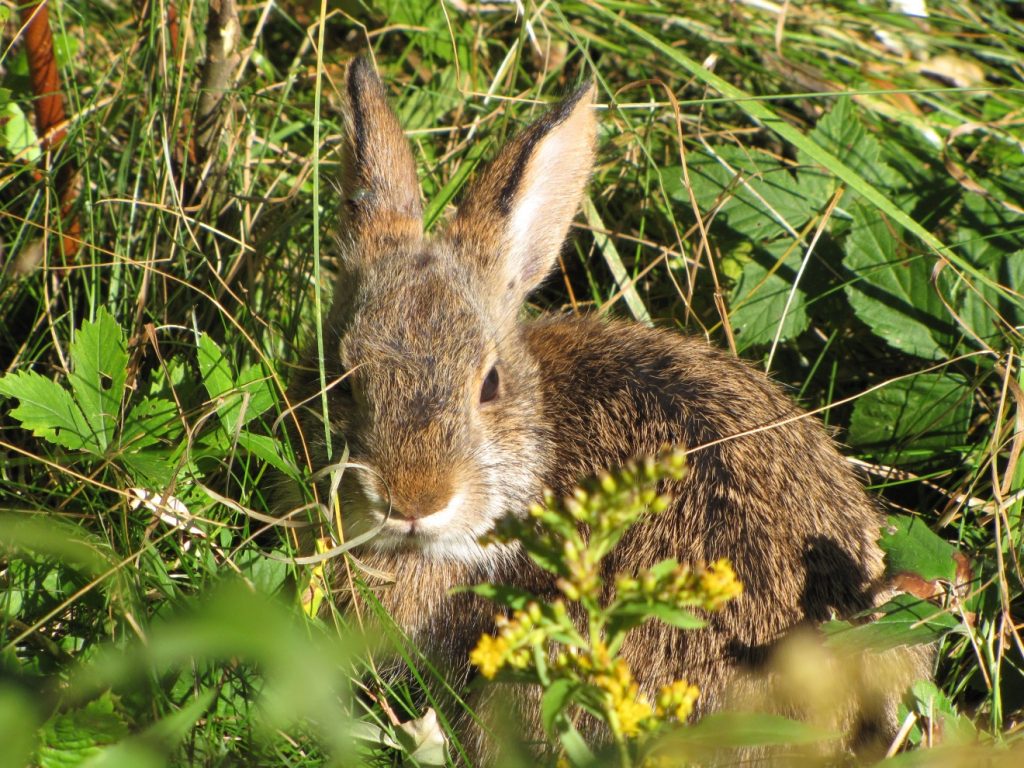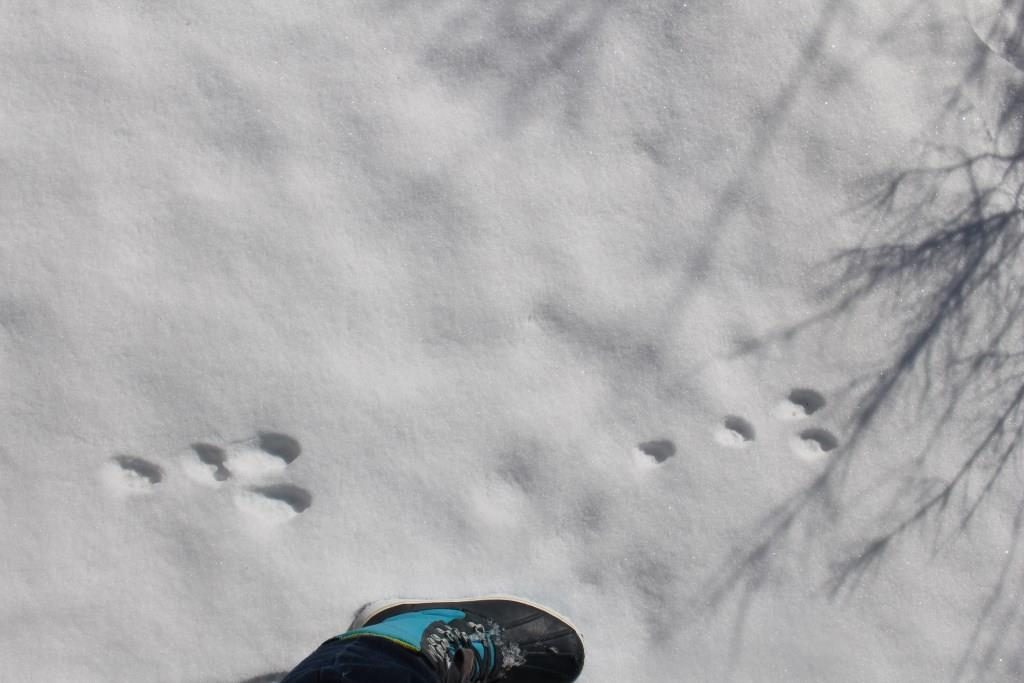January 4, 2017 at 2:53 pm
[caption id="attachment_2111" align="aligncenter" width="796"] A New England cottontail. One of the major differences in appearance between New England Cottontails and snowshoe hares is that cottontails remain brown in color during the winter, and snowshoe hares turn white. If you see a brown bunny this winter, let us know![/caption]
By IFW Wildlife Biologist Cory Stearns
Have you seen this rabbit? The New England cottontail is a State Endangered species in Maine, with an estimated population of less than 300. Each winter, biologists from the Maine Department of Inland Fisheries and Wildlife and our conservation partners conduct snow tracking surveys to monitor the sites known to have cottontails, and to search for new occurrences. So, if you’ve spotted a cottontail (see below for a comparison with the much more common snowshoe hare) please let us know so we can survey the site to confirm their presence. Knowing exactly where cottontails occur is critical to our efforts to restore the species, so we’d greatly appreciate any reports.
New England cottontails and snowshoe hares are very similar in appearance through much of the year, but cottontails are generally smaller than hares (though overlap does occur), with shorter ears, legs, and feet. They have a wider appearing face, and often have a black spot on their forehead (though it’s difficult to observe). Cottontail hindfoot tracks are oval shaped and 2 ¾ - 4” long; whereas hindfoot tracks for snowshoe hares are 3 ½ - 6” long and are more triangular (or snowshoe shaped). The two species are easily distinguished during winter, because cottontails remain brown in color, but snowshoe hares change to white. So, if you see a brown bunny in winter, please let us know!
[caption id="attachment_2113" align="alignright" width="536"]
A New England cottontail. One of the major differences in appearance between New England Cottontails and snowshoe hares is that cottontails remain brown in color during the winter, and snowshoe hares turn white. If you see a brown bunny this winter, let us know![/caption]
By IFW Wildlife Biologist Cory Stearns
Have you seen this rabbit? The New England cottontail is a State Endangered species in Maine, with an estimated population of less than 300. Each winter, biologists from the Maine Department of Inland Fisheries and Wildlife and our conservation partners conduct snow tracking surveys to monitor the sites known to have cottontails, and to search for new occurrences. So, if you’ve spotted a cottontail (see below for a comparison with the much more common snowshoe hare) please let us know so we can survey the site to confirm their presence. Knowing exactly where cottontails occur is critical to our efforts to restore the species, so we’d greatly appreciate any reports.
New England cottontails and snowshoe hares are very similar in appearance through much of the year, but cottontails are generally smaller than hares (though overlap does occur), with shorter ears, legs, and feet. They have a wider appearing face, and often have a black spot on their forehead (though it’s difficult to observe). Cottontail hindfoot tracks are oval shaped and 2 ¾ - 4” long; whereas hindfoot tracks for snowshoe hares are 3 ½ - 6” long and are more triangular (or snowshoe shaped). The two species are easily distinguished during winter, because cottontails remain brown in color, but snowshoe hares change to white. So, if you see a brown bunny in winter, please let us know!
[caption id="attachment_2113" align="alignright" width="536"] Track surveys during winter months let biologists know if New England Cottontails are present in an area.[/caption]
New England cottontails once ranged as far inland as Porter, Lewiston, and Augusta, and as far east as Belfast. But, they are now relegated to about 30 confirmed sites (within the last few years) south of Portland. In contrast, snowshoe hares occur statewide.
The primary factor causing the decline in the state’s cottontail population is the loss of the dense shrubby thickets and young regenerating forest habitat due to natural growth into older forests, development, and other changes in land use. As a result, as part of our restoration efforts we manage over 60 acres at Scarborough Marsh Wildlife Management Area for cottontails and other wildlife species (e.g., brown thrasher, American woodcock, prairie warbler) reliant on young forest habitat, and are developing plans to manage additional acreage in Mt. Agamenticus Wildlife Management Area.
For more information on New England cottontails or to report a sighting, please contact:
Cory Stearns
Assistant Regional Wildlife Biologist
358 Shaker Rd
Gray, ME 04039
(207) 657-2345 Ext 108
cory.r.stearns@maine.gov
Track surveys during winter months let biologists know if New England Cottontails are present in an area.[/caption]
New England cottontails once ranged as far inland as Porter, Lewiston, and Augusta, and as far east as Belfast. But, they are now relegated to about 30 confirmed sites (within the last few years) south of Portland. In contrast, snowshoe hares occur statewide.
The primary factor causing the decline in the state’s cottontail population is the loss of the dense shrubby thickets and young regenerating forest habitat due to natural growth into older forests, development, and other changes in land use. As a result, as part of our restoration efforts we manage over 60 acres at Scarborough Marsh Wildlife Management Area for cottontails and other wildlife species (e.g., brown thrasher, American woodcock, prairie warbler) reliant on young forest habitat, and are developing plans to manage additional acreage in Mt. Agamenticus Wildlife Management Area.
For more information on New England cottontails or to report a sighting, please contact:
Cory Stearns
Assistant Regional Wildlife Biologist
358 Shaker Rd
Gray, ME 04039
(207) 657-2345 Ext 108
cory.r.stearns@maine.gov
 A New England cottontail. One of the major differences in appearance between New England Cottontails and snowshoe hares is that cottontails remain brown in color during the winter, and snowshoe hares turn white. If you see a brown bunny this winter, let us know![/caption]
By IFW Wildlife Biologist Cory Stearns
Have you seen this rabbit? The New England cottontail is a State Endangered species in Maine, with an estimated population of less than 300. Each winter, biologists from the Maine Department of Inland Fisheries and Wildlife and our conservation partners conduct snow tracking surveys to monitor the sites known to have cottontails, and to search for new occurrences. So, if you’ve spotted a cottontail (see below for a comparison with the much more common snowshoe hare) please let us know so we can survey the site to confirm their presence. Knowing exactly where cottontails occur is critical to our efforts to restore the species, so we’d greatly appreciate any reports.
New England cottontails and snowshoe hares are very similar in appearance through much of the year, but cottontails are generally smaller than hares (though overlap does occur), with shorter ears, legs, and feet. They have a wider appearing face, and often have a black spot on their forehead (though it’s difficult to observe). Cottontail hindfoot tracks are oval shaped and 2 ¾ - 4” long; whereas hindfoot tracks for snowshoe hares are 3 ½ - 6” long and are more triangular (or snowshoe shaped). The two species are easily distinguished during winter, because cottontails remain brown in color, but snowshoe hares change to white. So, if you see a brown bunny in winter, please let us know!
[caption id="attachment_2113" align="alignright" width="536"]
A New England cottontail. One of the major differences in appearance between New England Cottontails and snowshoe hares is that cottontails remain brown in color during the winter, and snowshoe hares turn white. If you see a brown bunny this winter, let us know![/caption]
By IFW Wildlife Biologist Cory Stearns
Have you seen this rabbit? The New England cottontail is a State Endangered species in Maine, with an estimated population of less than 300. Each winter, biologists from the Maine Department of Inland Fisheries and Wildlife and our conservation partners conduct snow tracking surveys to monitor the sites known to have cottontails, and to search for new occurrences. So, if you’ve spotted a cottontail (see below for a comparison with the much more common snowshoe hare) please let us know so we can survey the site to confirm their presence. Knowing exactly where cottontails occur is critical to our efforts to restore the species, so we’d greatly appreciate any reports.
New England cottontails and snowshoe hares are very similar in appearance through much of the year, but cottontails are generally smaller than hares (though overlap does occur), with shorter ears, legs, and feet. They have a wider appearing face, and often have a black spot on their forehead (though it’s difficult to observe). Cottontail hindfoot tracks are oval shaped and 2 ¾ - 4” long; whereas hindfoot tracks for snowshoe hares are 3 ½ - 6” long and are more triangular (or snowshoe shaped). The two species are easily distinguished during winter, because cottontails remain brown in color, but snowshoe hares change to white. So, if you see a brown bunny in winter, please let us know!
[caption id="attachment_2113" align="alignright" width="536"] Track surveys during winter months let biologists know if New England Cottontails are present in an area.[/caption]
New England cottontails once ranged as far inland as Porter, Lewiston, and Augusta, and as far east as Belfast. But, they are now relegated to about 30 confirmed sites (within the last few years) south of Portland. In contrast, snowshoe hares occur statewide.
The primary factor causing the decline in the state’s cottontail population is the loss of the dense shrubby thickets and young regenerating forest habitat due to natural growth into older forests, development, and other changes in land use. As a result, as part of our restoration efforts we manage over 60 acres at Scarborough Marsh Wildlife Management Area for cottontails and other wildlife species (e.g., brown thrasher, American woodcock, prairie warbler) reliant on young forest habitat, and are developing plans to manage additional acreage in Mt. Agamenticus Wildlife Management Area.
For more information on New England cottontails or to report a sighting, please contact:
Cory Stearns
Assistant Regional Wildlife Biologist
358 Shaker Rd
Gray, ME 04039
(207) 657-2345 Ext 108
cory.r.stearns@maine.gov
Track surveys during winter months let biologists know if New England Cottontails are present in an area.[/caption]
New England cottontails once ranged as far inland as Porter, Lewiston, and Augusta, and as far east as Belfast. But, they are now relegated to about 30 confirmed sites (within the last few years) south of Portland. In contrast, snowshoe hares occur statewide.
The primary factor causing the decline in the state’s cottontail population is the loss of the dense shrubby thickets and young regenerating forest habitat due to natural growth into older forests, development, and other changes in land use. As a result, as part of our restoration efforts we manage over 60 acres at Scarborough Marsh Wildlife Management Area for cottontails and other wildlife species (e.g., brown thrasher, American woodcock, prairie warbler) reliant on young forest habitat, and are developing plans to manage additional acreage in Mt. Agamenticus Wildlife Management Area.
For more information on New England cottontails or to report a sighting, please contact:
Cory Stearns
Assistant Regional Wildlife Biologist
358 Shaker Rd
Gray, ME 04039
(207) 657-2345 Ext 108
cory.r.stearns@maine.govCategories